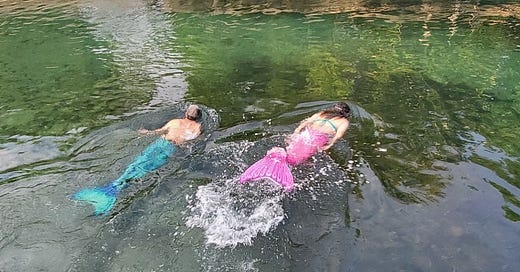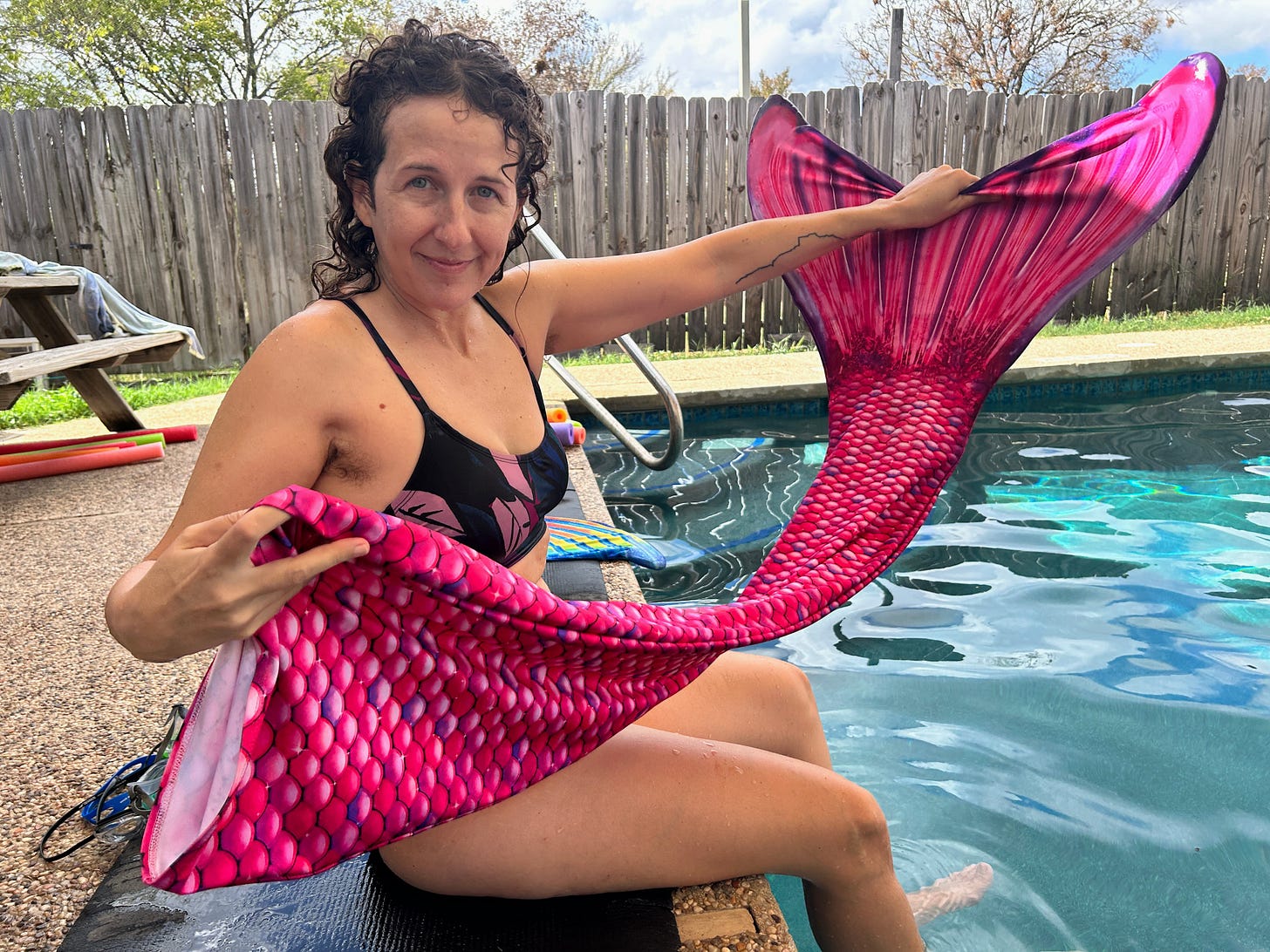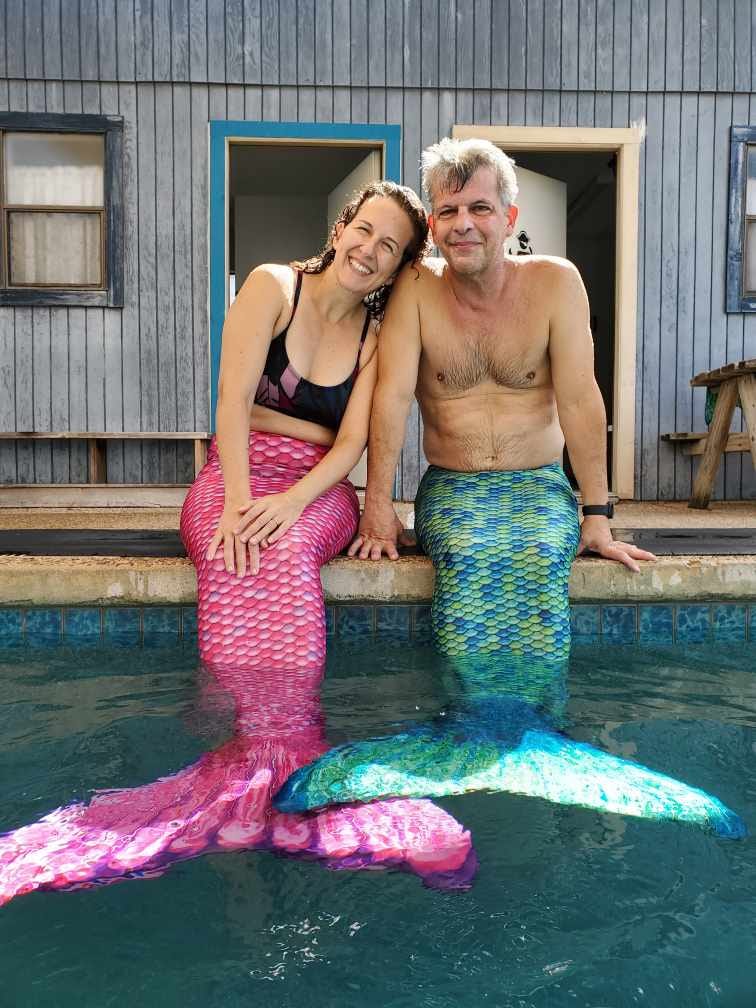Mermaiding was his idea, I promise
Two newlyweds, two tails and one San Marcos staycation to check off the only thing on my husband's bucket list.
My husband has always wanted to go to Weeki Wachee Springs in Florida to learn how to become a mermaid.
He grew up before the mermaid craze of the 1990s, when every young girl (and boy) in America dreamed of being Ariel or King Titan or one of extended mer-family from Disney’s “The Little Mermaid.” He remembers hearing about the underwater performers at this park in Florida who, since 1947, have been dazzling mermaid-loving visitors.
But mermaids, of course, have enchanted sailors (and everyday people) for millennia. In Denmark, the famous statue inspired by Danish author Hans Christian Andersen’s “Den lille Havfrue” has been used as a political talking piece since its unveiling in 1937, a hundred years after Andersen’s fairy tale was published to global acclaim.
In America, our more recent mermaid obsession can be traced to the 1989 film where millions of millennial children longed to be “Part of Your World,” but in reverse. Nobody wanted to walk on land. We all wanted to swim under the sea.
Last year, Netflix aired a four-part series called “MerPeople” about this mer-mania, as told by the people who attend festivals, pageants and conferences, some of whom attempt to turn their love of “mermaiding” into full-time jobs
Although I’ve never wanted to join this subculture of people who cosplay as mermaids by setting up elaborate photo shoots and forming “pods” with fellow mermaid aficionados, I have always shared Frank’s desire to at least try on a fin and see what it’s like.
I mean, how many of us grew up pretending to swim like a dolphin or a mermaid in every hotel pool we ever splashed into? But back then, nobody had a monofin. There weren’t Facebook groups to celebrate “mermaiding.” You couldn’t buy mermaid tails online, much less one that costs more than a plane ticket to Fort Lauderdale.
But this is the world that Ariel finds herself in now. No matter how far you are from a coastline, you’ll find grown adults who, in their free time, play mermaid. Some of them perform at aquariums or for children’s birthday parties. The top-tier mermaids, like Eric Ducharme of Mertailor, who was featured on the Netflix show, have made it their full-time jobs.
You can find inexpensive tails on Amazon, but the high-end silicone tails, like the ones from Mermaid Lucia, have a months-long wait and cost thousands of dollars.
My husband and I fall outside the category of people who dress up for the parade in San Marcos, the self-described “Mermaid Capital of Texas,” but we are certainly the kind of people who have no shame in taking a wild idea to fruition.
After Frank mentioned for the sixth or seventh time that it was his lifelong dream to go to Florida’s Weeki Wachee Springs for an adult mermaid camp, I started researching a trip closer to home where we could make it happen.
That’s how I found Michelle Kraft, who owns the legendary Dive Shop San Marcos, one of the longest-running educational hubs for SCUBA diving in Texas. The shop opened in the 1970s, and Michelle took it over in 2019.
She’s a serious technical diver who has taught and led hundreds of classes and excursions all over the world.
And a few years ago, she got into mermaiding, too.

Kraft is one of only a handful of dive instructors in the state who offers mermaid certifications through NAUI, the National Association of Underwater Instructors. (Both NAUI and PADI, the largest SCUBA certification organizations in the world, offer mermaid certifications now.)
So, for Frank’s birthday this year, I gave him mermaid classes, and the the last weekend in September, we headed to San Marcos for our two-day class with Kraft.

Kraft spends most of her time teaching SCUBA classes, but for the mermaid classes, she brings students to the heated pool at the dive shop just outside of town for the first day. On the second day, they meet at the San Marcos River, just downstream from where the “mermaids” used to perform at Aquarena Springs, the headwaters for the San Marcos River and is considered one of the cleanest rivers in the country.
Both Aquarena and Weeki Wachee started hosting mermaid shows in the late 1940s. It appears that perhaps Weeki Wachee was first, but Aquarena’s underwater theater was a close second. Texas State University removed the underwater theater in 2012, after the university bought the former amusement park grounds — where the famed swimming pigs drew crowds for nearly 50 years — and turned it into an educational facility called the Meadows Center.
The Meadows Center continues to host glass bottom boat tours and have recently expanded their public offerings to include stand-up paddleboards and night paddling in clear plastic kayaks. You can also sign up for snorkeling tours, but check the calendar and plan ahead. Although the boat tours depart daily, the other aquatic offerings take place only a few times a month.

Last month, Frank and I were the only students in this two-day class, so we had the pool all to ourselves to learn the first step of mermaiding: swimming with a monofin. (This is the single fin that keeps your feet together. The fabric tail that keeps your legs together comes later.) Although both of us had been “practicing” this skill for a long time — Frank is also a swimmer who does the butterfly stroke — it was surprisingly hard to do once your feet slipped into the pockets that hold them in the fin.
Kraft explained that learning to get out of the monofin quickly is just as important as learning how to swim in them. She said that people who want to mermaid often forget how dangerous this activity can be because your legs are restricted, so even strong swimmers can get themselves into trouble without realizing it.
After we got the hang of the monofin, we slipped on the fabric tails. He picked the green one. I got the pink one. This was the moment when the “mermaiding” really began.
We were having fun as soon as we got in the pool, but the moment we put on our tails, the magic happened. Something as familiar as treading water in a gently flowing river becomes entirely new. Each time we came up for air, we were laughing, grown adults having so much fun doing something that they’d secretly wanted to do all of their lives.
Not that we had “become” mermaids, but we had momentarily left behind the realities of an adulthood burdened with mind-numbing paperwork, anxiety-inducing schedules and the heart-piercing grief of watching the news.
The discovery of this new experience was all either of us could think about. We could suspend our disbelief for as long as we could hold our breath.
The next day, we met Kraft at Sewell Park for the second day of our class. She brought the fins and fabric tails, and we had to demonstrate that we could get in and out of them in the clear, brisk and moving water of the San Marcos River. The magic and the silliness returned, and we were thrown back into this dream-like state of “mermaiding.”
Within an hour, we were exhausted. I can see why professional mermaids have to spend so much time building up their stamina. This was an entirely different challenge, and I can see why Kraft doesn’t teach the classes entirely in the river.
She walked along the sidewalk as Frank and I swam down the river and frolicked in the deepest part, swimming down to the sea grass. I pulled out a sandal from the bottom and felt like I’d truly joined the ranks of the San Marcos mermaid community, which exists not for the playfulness of mermaiding but to promote environmental stewardship.
We grabbed lunch at the nearby Three Six General butcher shop and then spent the day resting and then walking around downtown San Marcos.
Kraft keeps the mermaid classes to no more than eight people, and kids as young as 8 years old can participate. It costs $125 per session, and you have to call the shop to get on her schedule.
There are other classes where you can learn how to mermaid, including a franchise called Aquamermaid that requires you to have or rent your own pool, and Mermaid Dream School, which seems to focus on kids in Austin, Houston, Dallas, and Fort Worth.
I think we’ll still try to get to Weeki Wachee at some point, but, even though the pigs and underwater mermaid theater are gone in San Marcos, I’m glad we got to experience mermaid culture there first.
Frank and I are still in our first year of marriage, and this escapade felt like something very newlywed to do.
The simplicity, the playfulness, the expression of the inner child, and all that laughter.
It helped me understand that the surge of interest in mermaiding is absolutely a response to the difficulties of dealing with life on two legs. There are no mass shootings or bombings when you’re swimming underwater. No fighting over politics or semantics.
I don’t even know if Frank could put into words why he was so drawn to this idea of learning how to mermaid, but I love that he could speak that dream out loud without fear of rejection or of what others would think of him.
Maybe that’s what all these mermaids do every time they put on a tail. They give all of us permission to express whatever dreams we might have — no matter how silly they might seem to people on land.
Happy Halloween, readers!
As we wrap up October, I wanted to share this story about our mermaid adventure last month. Over the next few weeks, I’m going to take you along on a whirlwind of travel, from Washington D.C. to Fort Wayne, Indiana and back up to Chicago, where I spent days immersing myself in educational travel.
I have stories about museums and outdoor adventures and genealogy centers and a very special gathering of Swedish-Americans that I never could have imagined attending just a few years ago.
I hope these stories inspire you to take a new look at the world around you and see an adventure or two you’d like to take.
A dream you’d like to tell someone and hope that they hear.
Sending much love,
Addie











My family visited Aquarena Springs around 89/90 and I vividly remember the show with mermaids and the swimming pig as well as the glass bottom boat ride.
I always wanted to visit the mermaid place in Florida when we lived there but never made it, but it used to be popular to watch films about it.